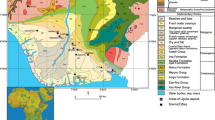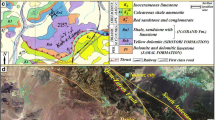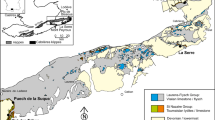Abstract
A tidal coast is documented in mixed siliciclastic and carbonate sands of the uppermost Muschelkalk (Middle Triassic) along the southwestern margin of the Germanic basin in Luxembourg. The coastal sediments are vertically and laterally stacked channel fills, interpreted to have formed in a tidal flat environment. The channel fills overlie carbonates of a shallow subtidal ramp. The strong progradation of the tidal flat indicates deposition during a late stage of sea-level highstand, but before sea-level fall. In their upper part, the channel fills are overprinted by a thick paleosol, which resulted from subaerial exposure around the time of the Muschelkalk/Keuper boundary. The exposure and formation of the paleosol in the subtidal coastal sediments and, in basinward sections, the deposition of dolomicrites above the Muschelkalk/ Keuper boundary in the lowermost Keuper both indicate a sea-level fall.
Similar content being viewed by others
Author information
Authors and Affiliations
Additional information
Received: 6 March 1997 / Accepted: 24 August 1997
Rights and permissions
About this article
Cite this article
Vecsei, A. A sandy tidal coast in the uppermost Muschelkalk and the origin of the Muschelkalk/Keuper boundary in the southwestern Germanic basin. Geol Rundsch 86, 835–851 (1998). https://doi.org/10.1007/s005310050180
Issue Date:
DOI: https://doi.org/10.1007/s005310050180




